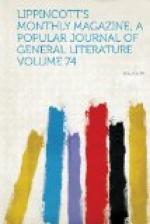There still it shines, while far abroad
The Christmas choir sings
now, as then,
“Glory, glory unto God!
Peace and good-will to men!”
ROME, Christmas, 1871.
T. BUCHANAN READ.
THE PARSEES.
Hanging in my study is a noteworthy portrait, generally the first object observed by those who enter. It is an exquisite painting on glass, the work of Lang Qua, the best artist China has produced in our day, and it delineates the form and features of a singularly handsome young man. But it is the quaint Parsee garb that first attracts attention; and the weird romance that attaches to the history of the Fire-worshipers gives this work of art its real value, rather than its lines of beauty or the celebrity of the painter’s name. This delicately-featured portrait may depict the countenance of Musaljee Jamsetjee Jejeebhoy, the first-born son and heir of the late Sir Jamsetjee Jejeebhoy, baronet, of Bombay, India. That he really sat for this portrait I cannot, however, positively assert, since I obtained the painting from an English officer, who bought it of the artist, but had “forgotten the strange, outlandish name of the Indian nabob,” as he said. It is certainly the portrait of a Parsee—true to the life in features and garb, and it bears a striking resemblance to the young Musaljee when about eighteen years of age. He was not then a personage of any great celebrity, though the worthy son of a most remarkable sire, the latter long known and honored in Europe for his liberal and enlightened charities, and especially for his munificent donations, that saved the lives of thousands of British subjects, during the terrible famines that occurred in India between the years 1840 and 1846. It was in grateful recognition of this noble philanthropy that Queen Victoria conferred upon him the honor of a baronetcy, sending out a nobleman to act as her proxy in the presentation of a sword which had been handled by more than one British monarch. Sir Jamsetjee was the first East Indian who ever received a title from a European sovereign. During the terrible famines alluded to he not only distributed daily from his own palace a plentiful supply of food to all who came, but he made also large donations of provisions to the English governor of Bombay for the supply of his starving troops. When, subsequently, pestilence followed in the footsteps of famine, this true-hearted philanthropist, overstepping all prejudices of creed and clan, built and endowed at his own expense a free hospital for the sick of all nations and religions. Temporary bamboo cottages at first received the sick till there was time for the erection of the present elegant structure, which is built in the Gothic style, and is capable of accommodating some six or eight hundred patients, besides nurses and attendants. The physicians have been from the beginning of the enterprise all English, as are many of the nurses,




